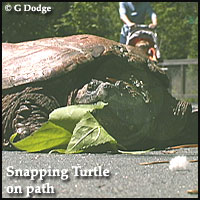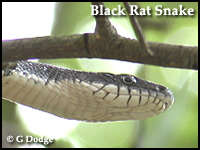 Top Photo: Yellow-bellied slider digs nest hole along path.
Top Photo: Yellow-bellied slider digs nest hole along path.
Over the past few weeks adult turtles have been seen walking across the paved path in both Catch the Wind and Explore the Wild. Adult turtles in our area, with the exception of Eastern Box Turtles, which are terrestrial, may be on land for several reasons. They may be looking for a better food source, a mate, or they may be headed off to lay eggs. If you see a turtle on the path it’s probably a good idea to leave it be. Water turtles are vulnerable on land and they show it. They usually retreat into their shells when approached, but some, like Snapping Turtles, may become rather cranky when disturbed, and they can move much more quickly than you may think. If you happen to see one of these bruins crossing the path, let a Museum employee know what you’ve found and they’ll do what’s appropriate for the situation.
 Snakes have also been reported crossing the path in both Catch the Wind and Explore the Wild. Besides eating small mammals, Black Rat Snakes are well known for climbing trees in search of birds’ eggs. Since this is the season when many birds are nesting, the snakes are moving around looking for food. I witnessed one of these snakes raid a Gray Catbird’s nest on May 16 behind the Ornithopter. Black Rat Snakes will not harm you, but I’d advise anyone seeing a snake to simply observe.
Snakes have also been reported crossing the path in both Catch the Wind and Explore the Wild. Besides eating small mammals, Black Rat Snakes are well known for climbing trees in search of birds’ eggs. Since this is the season when many birds are nesting, the snakes are moving around looking for food. I witnessed one of these snakes raid a Gray Catbird’s nest on May 16 behind the Ornithopter. Black Rat Snakes will not harm you, but I’d advise anyone seeing a snake to simply observe.
Towards the end of the day on Sunday, May 18, a thunder storm came barreling through. As the last remaining Museum guests headed towards the shelter of the main building, the winds began to roar through the trees, the skies began to darken, the thunder clapped, and Gray Tree Frogs and Green Tree Frogs began to call out loudly in anticipation of what was to come. Gray Tree Frogs and Green Tree Frogs breed during warm spring or summer rains. They usually breed at night but also take advantage of dark rainy days to procreate. The frogs definitely knew what was headed their way.
Bullfrogs usually take a year to mature, although they may take longer. Their large tadpoles can easily be seen from the Wetlands Overlook. Recently, many of these tadpoles have been seen sporting legs. Those tadpoles will become frogs this year, that is, of course, if a Green Heron doesn’t get them first (photo on left).